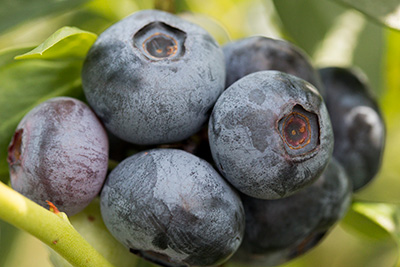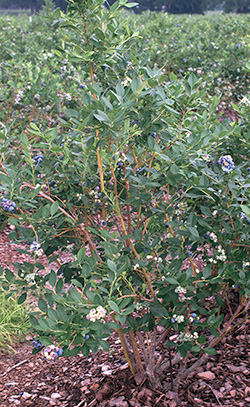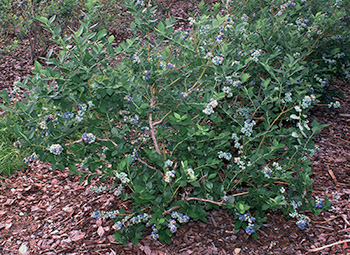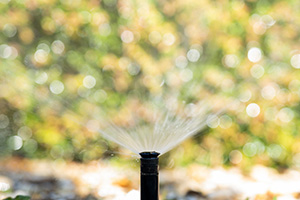Blueberries
Blueberries are a favorite summer treat and an important commercial crop in Florida.

Luckily, they thrive in home gardens too. Our winters aren’t cold enough for northern blueberry varieties, so the University of Florida and others have developed low-chill cultivars that can grow here. Rabbiteye blueberries are generally grown in areas of Florida that have winters as cold or colder than Ocala, while southern highbush is best suited to locations south of Ocala and north of Sebring.
Characteristics
Keep in mind that most blueberry cultivars require cross-pollination from another cultivar. This means you will need to plant more than one cultivar in order to enjoy a full harvest. The cultivars must be of the same type, meaning that rabbiteye will only cross-pollinate with other rabbiteye cultivars and southern highbush will cross-pollinate with other southern highbush cultivars. Pollinators (typically bees) are also necessary for optimal berry yields, so practice pollinator-friendly gardening techniques.
Southern Highbush
Southern highbush blueberries are best suited to Central and South Central Florida since they aren’t as cold tolerant as rabbiteye. However, southern highbush cultivars can be grown in North Central Florida with protection from late freezes and frosts. Although they are typically more difficult to grow, they reward the gardener with the earliest harvest in North America.
| Cultivar | Location | Benefits | Considerations |
|---|---|---|---|
| ‘Emerald’ | Gainesville to Sebring | Vigorous bush, early ripening, large, high-quality berries | |
| ‘Jewel’ | Gainesville to Sebring | Low chilling requirement, early ripening, high berry quality | Moderately susceptible to Phytophthora root rot and highly susceptible to rust leaf spot disease |
| ‘Star’ | Southeast Georgia to North Florida | Medium vigor, high survival, excellent berries | Higher chilling requirement; only 3-week-long harvest period |
| ‘Windsor’ | North-Central Florida | Vigorous, semi-spreading growth habit, large berries | Berries have a deep picking scar, but this generally only causes issues commercially |
| ‘Springhigh’ | North and Central Florida | Vigorous, excellent survival, darker berries | Berry skin tends to tear during harvest; flower thrips management is necessary |
| ‘Sweetcrisp’ | South Georgia to North Florida | Exceptional berry quality and postharvest life | Below average yield and berry size |
| ‘Farthing’ | North-Central Florida | Vigorous, relatively free of disease, large, firm berries, higher yields | Dormant pruning can be necessary to prevent over-fruiting |
Rabbiteye
Generally, rabbiteye cultivars are easier to grow than southern highbush. They are more drought tolerant, less susceptible to cold damage and root rot, and are more vigorous than southern highbush. Rabbiteye fruits have slightly thicker skin and larger seeds than the southern highbush and tend to store better as a result.
| Cultivar | Location | Benefits | Considerations |
|---|---|---|---|
| ‘Beckyblue’ ‘Bonita’ ‘Climax’ | North and North-Central Florida | Extended rabbiteye harvest season | Less productive |
| ‘Brightwell’ ‘Powderblue’ Tiftblue’ ‘Woodard’ | North Florida and Panhandle | More productive, less susceptible to frost |
Planting

Both rabbiteye and southern highbush do best in acidic soils with high organic matter. To achieve this, peat moss can be applied prior to or during planting. Pine bark can also be incorporated into the soil or used as mulch. You should test your soil to make sure it is between a pH of 4 and 5.5. If it is too basic, you can either mix a small amount of sulfur into the soil several months before planting or apply fertilizer that is acid forming (many are). Adding sulfur ahead of planting is generally preferred when a stronger acidification response is needed.
Your planting area should have well-drained soil at least 18 inches deep to prevent root rot. You can build raised beds if your soil conditions are not ideal. Plant your blueberries in an area that gets at least 4-5 hours of full sun and is at least 20 feet away from buildings. Blueberries thrive when planted next to pine trees, but avoid planting near other tree roots. Each rabbiteye bush needs a circle of space that is 10 feet in diameter (radius of five feet) and each southern highbush plant needs a circle of space with a diameter of six feet (radius of three feet). For a hedgerow effect, plant southern highbushes three feet apart, or five feet apart for rabbiteye.
You can also plant your blueberries in containers using specially formulated blueberry soil mixes. Southern highbush is better suited to container plantings that rabbiteye, and as a bonus they are easier to protect from frost in containers.
Blueberries are best planted during the winter before spring growth begins. You can purchase either bare-root or container plants. Container-grown plants are most common and may be planted at other times of the year if proper attention is given to irrigation during plant establishment. Look for plants that are about one-and-a-half- to two-feet tall with root systems that are developed but not pot bound. For bare-root plants, keep the roots moist prior to and during planting.
Once you have your hole dug, incorporate a quarter to a half-cubit foot of acidic sphagnum peat moss into the soil. Make sure the hole is large enough to accommodate the roots and allow the plant to be set at the soil level. For a container plant, remove it from the pot, slightly loosen the roots, and place it in the hole. Bare-rooted plants should have their roots spread out evenly in the hole before filling in with soil. For raised bed plantings, set the plant slightly lower than the soil around it so irrigation and rainwater will flow to the roots.

Mulching after planting is necessary to prevent weed growth, moderate soil temperature fluctuations, protect the plant from mechanical damage, and provide a source of organic matter. Spread a three-inch layer of pine bark in a circle two feet in diameter from the plant, or apply a four-foot-wide strip of pine bark down the entire row.
The last step in planting is pruning. Prune the weak, twiggy growth at the base of the plant, but leave the tallest strong cane alone. If the plant has a much larger top than root system, then remove the upper third of the plant by pruning weaker growth and cutting back the top several inches-worth of vigorous canes. It is best to remove the fruit and flowers during the establishment year as well.
Maintenance
Frequent, light fertilization works best for blueberries since they are shallow-rooted and sensitive to overfertilization. Special blueberry fertilizers are widely available at garden centers in the correct quantities for home growers. This fertilizer should be spread in an even circle around the plant no further than two feet out. Repeat this application in April, June, August, and October.
Little irrigation is typically needed during the winter, although plants should not be allowed to dry out. As spring growth emerges (usually in late February or early March) plant water requirements increase rapidly. The exact water requirement depends on plant size and exposure, growth stage, and weather conditions. Check the predicted weekly rainfall before irrigating since rain contributes to these water needs. If you are growing southern highbush blueberries on sandy soils, they may need more irrigation during dry spells. Test your soil pH annually if you have high-pH water, such as water from deep wells.
Be sure to weed at least three feet around your plants; weeds compete for resources. Maintaining the mulch you applied at planting will prevent weed growth and acidify the soil, keeping the mulch layer several inches thick.

Young plants may not require much pruning other than flower and fruit removal during the establishment year. However, annual pruning of mature plants balances vegetative growth and berry production. After harvest, remove about a quarter to one third of the canopy by cutting back from the top of the plant. This stimulates new growth and controls plant height.
As plants age (four to five years or older), remove one or two older canes to stimulate new cane growth. Selectively remove weak twiggy growth from the canopy, leaving the stronger, more vigorous wood. This type of pruning is usually done in the late winter.
Although blueberries can fall prey to many pests and diseases, there typically aren’t severe issues with home plantings. However, blueberry plants are susceptible to root rot, flower blight (gray mold), stem blight, and a few pests. If you spot concerning damage on your blueberry plants, reach out to your county Extension office for advice.
With proper planting and maintenance, you’ll be enjoying the fruits of your labor after a couple of years!
For more information on growing blueberries in your area, contact the experts at your county Extension office: go.ufl.edu/Extension.
